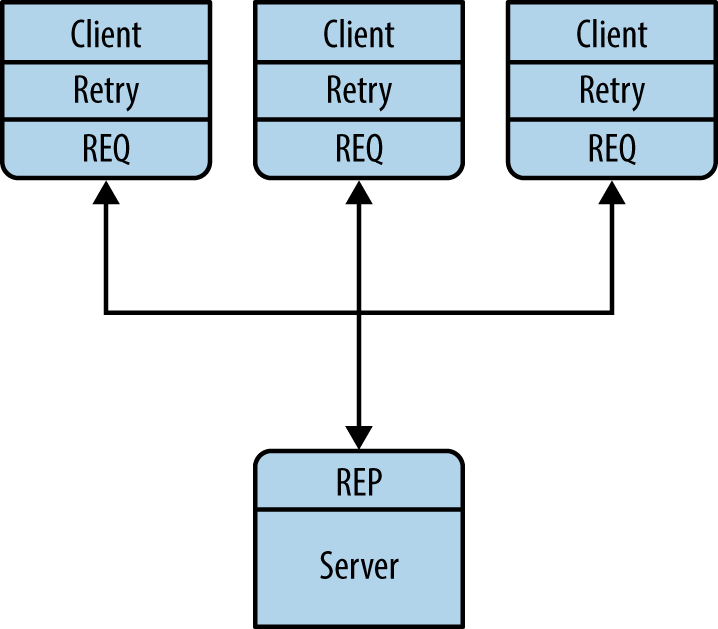We can get very simple, reliable request-reply with some changes to the client. We call this the Lazy Pirate pattern (Figure 4-1). Rather than doing a blocking receive, we:
Poll the REQ socket and receive from it only when itâs sure a reply has arrived.
Resend a request, if no reply has arrived within a timeout period.
Abandon the transaction if there is still no reply after several requests.
If we try to use a REQ socket in anything other than a strict send/receive fashion, weâll get an error (technically, the REQ socket implements a small finite-state machine to enforce the send/receive ping-pong, so the error code is called âEFSMâ). This is slightly annoying when we want to use REQ in a Pirate pattern, because we may send several requests before getting a reply, as you can see in Example 4-1. The pretty good brute-force solution is to close and reopen the REQ socket after an error.
Example 4-1. Lazy Pirate client (lpclient.c)
//// Lazy Pirate client// Use zmq_poll to do a safe request-reply// To run, start lpserver and then randomly kill/restart it//#include "czmq.h"#define REQUEST_TIMEOUT 2500// msec (> 1000!)#define REQUEST_RETRIES 3// Before we abandon#define SERVER_ENDPOINT "tcp://localhost:5555"intmain(void){zctx_t*ctx=zctx_new();printf("I: connecting to server...\n");void*client=zsocket_new(ctx,ZMQ_REQ);assert(client);zsocket_connect(client,SERVER_ENDPOINT);intsequence=0;intretries_left=REQUEST_RETRIES;while(retries_left&&!zctx_interrupted){// We send a request, then we work to get a replycharrequest[10];sprintf(request,"%d",++sequence);zstr_send(client,request);intexpect_reply=1;while(expect_reply){// Poll socket for a reply, with timeoutzmq_pollitem_titems[]={{client,0,ZMQ_POLLIN,0}};intrc=zmq_poll(items,1,REQUEST_TIMEOUT*ZMQ_POLL_MSEC);if(rc==-1)break;// Interrupted
Example 4-2 shows how we process a server reply and exit our loop if the reply is valid. If we didnât receive a reply, we close the client socket and resend the request. We try a number of times before finally abandoning.
Example 4-2. Lazy Pirate client (lpclient.c): process server reply
if(items[0].revents&ZMQ_POLLIN){// We got a reply from the server, must match sequencechar*reply=zstr_recv(client);if(!reply)break;// Interruptedif(atoi(reply)==sequence){printf("I: server replied OK (%s)\n",reply);retries_left=REQUEST_RETRIES;expect_reply=0;}elseprintf("E: malformed reply from server: %s\n",reply);free(reply);}elseif(--retries_left==0){printf("E: server seems to be offline, abandoning\n");break;}else{printf("W: no response from server, retrying...\n");// Old socket is confused; close it and open a new onezsocket_destroy(ctx,client);printf("I: reconnecting to server...\n");client=zsocket_new(ctx,ZMQ_REQ);zsocket_connect(client,SERVER_ENDPOINT);// Send request again, on new socketzstr_send(client,request);}}}zctx_destroy(&ctx);return0;}
We run this together with the matching server, shown in Example 4-3.
Example 4-3. Lazy Pirate server (lpserver.c)
//// Lazy Pirate server// Binds REQ socket to tcp://*:5555// Like hwserver except:// - echoes request as-is// - randomly runs slowly, or exits to simulate a crash.//#include "zhelpers.h"intmain(void){srandom((unsigned)time(NULL));void*context=zmq_ctx_new();void*server=zmq_socket(context,ZMQ_REP);zmq_bind(server,"tcp://*:5555");intcycles=0;while(1){char*request=s_recv(server);cycles++;// Simulate various problems, after a few cyclesif(cycles>3&&randof(3)==0){printf("I: simulating a crash\n");break;}elseif(cycles>3&&randof(3)==0){printf("I: simulating CPU overload\n");sleep(2);}printf("I: normal request (%s)\n",request);sleep(1);// Do some heavy works_send(server,request);free(request);}zmq_close(server);zmq_ctx_destroy(context);return0;}
To run this test case, start the client and the server in two console windows. The server will randomly misbehave after a few messages. You can check the clientâs response. Here is typical output from the server:
I: normal request (1) I: normal request (2) I: normal request (3) I: simulating CPU overload I: normal request (4) I: simulating a crash
And here is the clientâs response:
I: connecting to server... I: server replied OK (1) I: server replied OK (2) I: server replied OK (3) W: no response from server, retrying... I: connecting to server... W: no response from server, retrying... I: connecting to server... E: server seems to be offline, abandoning
The client sequences each message and checks that replies come back exactly in order: that no requests or replies are lost, and no replies come back more than once or out of order. Run the test a few times until youâre convinced that this mechanism actually works. You donât need sequence numbers in a production application; they just help us trust our design.
The client uses a REQ socket, and it does the brute-force close/reopen because REQ sockets impose that strict send/receive cycle. You might be tempted to use a DEALER instead, but it would not be a good decision. First, it would mean emulating the secret sauce that REQ does with envelopes (if youâve forgotten what that is, itâs a good sign you donât want to have to do it). Second, it would mean potentially getting back replies that you didnât expect.
Handling failures only at the client works when we have a set of clients talking to a single server. This design can handle a server crash, but only if recovery means restarting that same server. If thereâs a permanent error, such as a dead power supply on the server hardware, this approach wonât work. Because the application code in servers is usually the biggest source of failures in any architecture, depending on a single server is not a great idea.
So, the pros and cons are:
Get ZeroMQ now with the O’Reilly learning platform.
O’Reilly members experience books, live events, courses curated by job role, and more from O’Reilly and nearly 200 top publishers.


